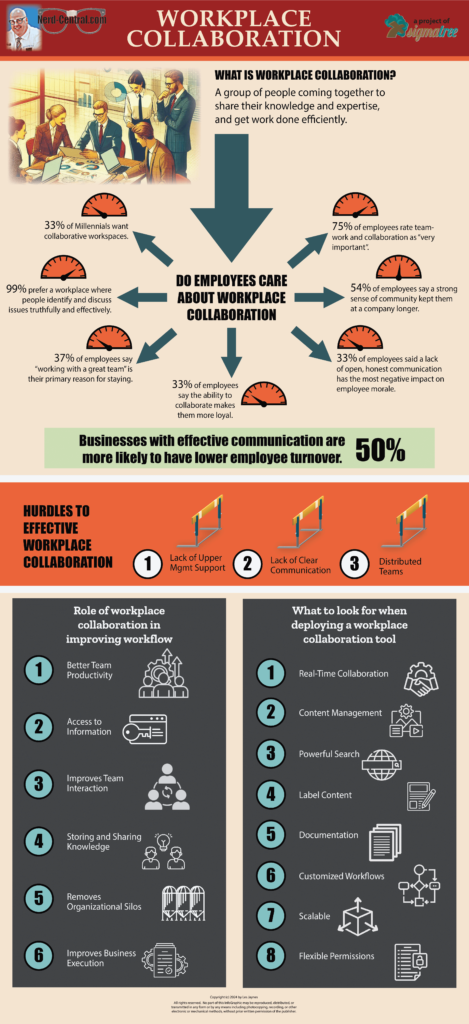
A company is only as successful as the people working in it. Success takes place when all the departments of an organization – from product development and marketing, to supply chain and customer service, come together to solve a customer problem and deliver an exceptional experience.
“Coming together is a beginning, staying together is progress, and working together is success.” – Henry Ford
Success, however, never seems to come easy. Every day there’s a new fire to be put out. A new challenge to be embraced. A new competitor to compete with. A new technology to learn. However, the journey becomes much easier when you have people in the organization ready to address the issues and solve the problems.
Collaboration and teamwork are some of the most underutilized, yet the most important tools a business can have to achieve success. Employees complementing each other’s strengths and weaknesses eventually becomes an unstoppable force.
“No matter how brilliant your mind or strategy, if you’re playing a solo game, you’ll always lose out to a team.” – Reid Hoffman
Even though collaboration can increase workplace productivity, incite creativity, build a sense of community, fill employees with a strong sense of purpose, improve problem-solving, give them a goal to strive for, and lead to groundbreaking innovations and ideas, it remains one of those commonly underutilized instruments in the workplace.
A culture of collaboration and transparent communication is not something that comes naturally to people.
We all like to work without any external distractions, working in silos in our cubicles. And the more departments a company has, the more disjointed the employees become.
What is Workplace Collaboration?
Workplace collaboration occurs when a group of people come together, share their knowledge and expertise, and get work done efficiently.
At its essence, collaborating and getting things done is workplace collaboration. This may include the use of workplace technologies like apps, tools, procedures, software, processes, or an entirely new methodology of getting work done.
It is a mindset that facilitates improved efficiency and workflow.

Workplace collaboration aims to improve communication, create a healthy and judgment-free work environment, and facilitate the free flow of information across the organization and leads to increased productivity and employee efficiency.
Do Employees Care About Workplace Collaboration?
Employees want to do work that makes a difference to the company’s bottom line and makes them feel like a part of something bigger than themselves.
Take a look at these collaboration stats that justify employee’s interest in workplace collaboration:
- About 75% of employers rate teamwork and collaboration as “very important”
- 33% of Millennials want collaborative workspaces
- 54% of employees say a strong sense of community (great coworkers, celebrating milestones, a common mission) kept them at a company longer
- 99.1% prefer a workplace where people identify and discuss issues truthfully and effectively.
- 33% of employees said a lack of open, honest communication has the most negative impact on employee morale.
- 37% of employees say “working with a great team” is their primary reason for staying
- Businesses with effective communication are 50% more likely to have lower employee turnover.
- 33% of employees say the ability to collaborate makes them more loyal
People like working and staying in an organization that fosters team and collaboration and has a clear line of communication. However, 86% of employees and executives cite a lack of collaboration or ineffective communication for workplace failures.

If everyone is on board with having workplace collaboration and systems in place to get work done efficiently, then why are the majority of businesses having trouble implementing them?
Hurdles to Effective Workplace Collaboration
There can be a number of hurdles that hinder an organization’s attempt to workplace collaboration. Some of these include:
1. Lack of Upper Management Support
Every behavior in an organization starts at the top. If the leaders or managers are not aware of the benefits of collaboration in the workplace or don’t follow the guidelines themselves, it’s highly unlikely that employees will do their part in promoting collaboration.
2. Lack of Clear Communication
One study shows that 69% of managers are afraid of communicating with their teams. This lack of clear communication often results in employees leaving the company, resulting in high staff turnover.
If there’s a lack of communication in the organization, goals are often misinterpreted, leading to duplication of work, poor quality of output, and confusion. Fifteen percent of an employee’s total work time—over 300 hours a year—is wasted in inefficient or ineffective communications.
3. Distributed Teams
Thanks to the internet, teams can now work from anywhere in the world. This means that you can hire talented people from all around the world and have your business function 24 hours a day. However, this has led to problems that are new to organizations.
Not being able to sit and talk face to face can lead to a disjointed team effort. On top of that, access to information (documents, files, and other important media) can be a bit difficult, especially if you still operate on paper documents.
The Dawn of Digital Workplace Collaboration

The adoption of workplace collaboration tools by organizations has significantly gone up in recent times. Since a massive 91 percent of people who work from home feel that they’re more productive than when they’re in an office, businesses are increasingly looking for ways to set up collaborative systems in this new digital age.
These tools, known as digital collaboration tools, are helping employees to collaborate on work using technology and digital devices.
Digital collaboration aims to improve information flow, communication, collaboration, document and content management across the organization, leading to increased productivity and employee efficiency.
Apart from office software, the cloud is an essential part of digital collaboration as it ensures that companies can function beyond geographical boundaries and standard work timings.
Role of workplace collaboration in improving workflow
1. Better Team Productivity
Digital collaboration increases productivity as people are able to skip the long commute to the office, time searching for information in the office, as well as administrative tasks that can be handled easily by technology.
Real-time communication apps can get you in touch with your team members in seconds, rather than waiting for them to reply to your email.
2. Access to Information
Almost 20% of the business time – the equivalent of one day per working week – is wasted by employees searching for information to do their job.
Searching for documents in the file cabinets, looking for content in Google Drive, or searching an endless list of folders in your laptop – all lead to enormous waste of time.
Digital collaboration tools improve workflow by making sure every employee has access to the information they need when they need it.
It acts as a central location for all documents, media, and files, etc which employees can access irrespective of their location. Employees no longer need to save files to their hard drives or USBs – just log in to your digital workplace tool and you’re good to go.
3. Improves Team Interaction
Digital tools have made it really easy for teams, especially the ones which are geographically dispersed, to communicate with each other at any point in time, via text, audio or video.
You can carry out full-blown meetings, collaborate on digital whiteboards, share screens, give design feedback, collaborate and write on a document with multiple people, and so much more.
Knowledge workers spend an average of 14% of their workweek in communicating and collaborating internally.
4. Storing and Sharing Knowledge
According to another study, Fortune 500 companies lose roughly $31.5 billion a year by failing to share knowledge. Digital workplace tools like knowledge management software allows organizations to document the know-how and experience of senior executives which can be used to train future hires.
In this way, the knowledge of the organization does not leave when the employee does. With a knowledge management system in place, your current or future employees can easily access this information.
5. Remove Organizational Silos
Most organizations appear as a single unit to the outside world but are often divided into numerous specialized departments.
These silos are often a major hurdle to collaboration in the workplace as it prevents the information and knowledge flow from one department or employee to another.
Digital collaboration opens up a number of opportunities to keep in touch with your teammates at all times.
Real-time collaboration tools have increased clarity amongst employees and are helping them develop better interdepartmental relations.
6. Improved Business Execution
With the mobile-first approach of today’s communication and collaboration, employees can tackle business problems on the go. To elevate the point, 49% of the participants claimed to use mobile devices for collaboration and 92% of them think it is important.
Up to 80% of businesses use social collaboration tools for enhancing business processes. Some digital collaboration platforms provide a one-stop-solution for teammates to work, document, chat, share, and store data, enabling them to make decisions quickly and swiftly.
These tools allow employees to always be in the know-on what’s happening and provide them with the tools they need to brainstorm and come up with newer ways of solving a problem.
Things to Look For While Deploying a Workplace Collaboration Tool
There are a number of productivity and collaboration tools out there that can help you improve workplace collaboration and get work done- Communication / messaging apps, internal wiki tools, document editors, file sharing apps, cloud storage apps, knowledge management systems, content management systems, and more!
The challenge is not finding a workplace collaboration tool for your organization. The challenge is to find the right one. The more apps and tools you end up using in your day-to-day, the more your work gets segregated amongst these tools, and the more difficult it gets to actually make sense of the information.
A great workplace collaboration tool is the one that combines the power of all tools into one, i.e. becoming your go-to tool for everything you need to collaborate with your co-workers.
An ideal collaboration tool should be able to provide a flexible workspace where employees from different departments can collaborate, brainstorm, give feedback, and create resources that are easy to find and follow.
At the same time, it should be intuitive enough for anyone in the company to understand and get started with right away.
So while selecting a workplace collaboration tool for your organization, make sure it has these key features in order for it to be effective and useful:
1. Real-Time Collaboration
A competent workplace collaboration tool must provide real-time collaboration.
This will give employees the possibility to work together simultaneously, brainstorm concepts, innovate, and find improved ways to solve problems with their collective experience and wisdom.
2. Content Management
We produce a ton of content on a daily basis- from your workplace documents, PDFs, presentations, files, Excel sheets, SlideShares, YouTube videos, URLs, images, logos, or even social media content.
A great advantage of having a collaboration tool setup is that you don’t have to spend hours searching for a file on your PC or cloud folders as all your content is accessible via the collaboration tool.
It is, therefore, the utmost necessity for a workspace collaboration tool to have content management capabilities for easy access to files and media.
Make sure that your workspace collaboration tool has features like “restricted access” or content control so that only employees that have access can view and share the files.
3. Powerful Search
Having content management capabilities is great, but it’s almost of no use if you don’t have a powerful search system to get the file you are looking for quickly.
Data is only useful when the right information is made available at the right time. You want to reduce the amount of crucial time your employees spend looking for something and for that, a powerful search feature is a must.
4. Label Content
In order to make the most of the powerful search functionality, you must be able to add tags, titles, & descriptions to every piece of digital content that gets stored in your internal knowledge base.
Your team needs to be able to categorize and add details to make information easier to search, find and work with.
5. Documentation
Documents are the bread and butter of a business. Every business produces a ton of documents on a daily basis – How-to guides, process sheets, training documents, HR policies and guidelines, reports, applications, common workflows, shared logins, procedure checklists and more.
A collaboration tool should make the process of documentation and content creation as easy and robust as possible. It should also be noted that the documents created should be visually pleasing, dynamic and responsive (can be viewed on different devices).
6. Customized Workflows
The goal of a collaboration tool is to allow the sharing of information amongst employees across various departments for effective decision making and collaboration.
The tool should facilitate this process by tearing down organizational silos and facilitate the smooth flow of cross-departmental information sharing.
7. Scalable
The amount of content production will increase as your organization grows.
An effective collaboration tool must be able to support your growth and the increased volume of content with it. It should be flexible enough to grow with your growing business and support new hires and consequently, more content.
8. Flexible Permissions
Even though a workflow collaboration tool should generally be company-wide, there may be certain sensitive documents where you want to invoke user access and permissions (ex: making some content “view only”).
Thus, a collaboration tool must support effective user management, allowing executives to manage user roles and permission levels that work for your company structure. Features like password protection, file access restrictions, document tracking, etc. are important to keep data safe and sound.

Final Words…
When employees come together and combine their knowledge and expertise, big things happen. Make sure your workplace has a strong culture of collaboration to stay ahead of the competition and achieve success.
Check out the infographic that summarized this content at the following location.





